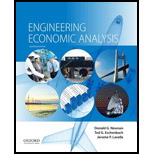
(a)
The after tax
Answer to Problem 23P
The after tax rate of return is
Explanation of Solution
Concept used:
Write the expression for
Here, book value is
Write the expression for taxable income.
Here, before tax cash flow is
Write the expression for income tax.
Write the expression for after tax cash flow.
Write the expression for after tax rate of return.
Here, the present value of the annuity is
Write the expression for rate of return by linear interpolation.
Here, lower interest rate is
Calculation:
Calculate depreciation.
Substitute
Substitute
Substitute
Substitute
Calculate taxable income.
Substitute
Substitute
Substitute
Substitute
Substitute
Substitute
Calculate income tax.
Substitute
Substitute
Substitute
Substitute
Substitute
Substitute
Calculate after tax cash flow.
Substitute
Substitute
Substitute
Substitute
Substitute
Substitute
The table for the calculated values is shown below.
| Year | Before Tax Cash Flow | Depreciation | Taxable Income | Tax | After Tax Cash Flow |
| 0 | |||||
| 1 | |||||
| 2 | |||||
| 3 | |||||
| 4 | |||||
| 5 | |||||
| 6 |
Table (1)
Calculate the after tax rate of return.
Substitute
Consider the table and apply trial and error method equalizing the equation (VII).
Determine an interest rate which equalizes left hand side and right hand side of Equation (VII).
Substitute the tabular values into the right hand side of the equation (VII).
The table for values close to the left hand side of the equation (VII) is shown below.
| Interest rate | Value |
Table (2)
Calculate the rate of return by linear interpolation.
Substitute
Conclusion:
Thus, the internal rate if return is
(b)
The reason for the difference in the rate of return obtained in part (a) and the rate of return obtained in Problem 12-22.
Answer to Problem 23P
Interest is deductible so it reduces the tax liability and the after tax cash flow of the loan. Therefore there the rate of return obtained in part (a) is different from the rate of return obtained in Problem 12-22.
Explanation of Solution
In the previous problem the total purchasing amount of the tools was
Want to see more full solutions like this?
Chapter 12 Solutions
Engineering Economic Analysis

 Principles of Economics (12th Edition)EconomicsISBN:9780134078779Author:Karl E. Case, Ray C. Fair, Sharon E. OsterPublisher:PEARSON
Principles of Economics (12th Edition)EconomicsISBN:9780134078779Author:Karl E. Case, Ray C. Fair, Sharon E. OsterPublisher:PEARSON Engineering Economy (17th Edition)EconomicsISBN:9780134870069Author:William G. Sullivan, Elin M. Wicks, C. Patrick KoellingPublisher:PEARSON
Engineering Economy (17th Edition)EconomicsISBN:9780134870069Author:William G. Sullivan, Elin M. Wicks, C. Patrick KoellingPublisher:PEARSON Principles of Economics (MindTap Course List)EconomicsISBN:9781305585126Author:N. Gregory MankiwPublisher:Cengage Learning
Principles of Economics (MindTap Course List)EconomicsISBN:9781305585126Author:N. Gregory MankiwPublisher:Cengage Learning Managerial Economics: A Problem Solving ApproachEconomicsISBN:9781337106665Author:Luke M. Froeb, Brian T. McCann, Michael R. Ward, Mike ShorPublisher:Cengage Learning
Managerial Economics: A Problem Solving ApproachEconomicsISBN:9781337106665Author:Luke M. Froeb, Brian T. McCann, Michael R. Ward, Mike ShorPublisher:Cengage Learning Managerial Economics & Business Strategy (Mcgraw-...EconomicsISBN:9781259290619Author:Michael Baye, Jeff PrincePublisher:McGraw-Hill Education
Managerial Economics & Business Strategy (Mcgraw-...EconomicsISBN:9781259290619Author:Michael Baye, Jeff PrincePublisher:McGraw-Hill Education





